Effect of Microstructure on Mechanical Properties of 316 LN Austenitic Stainless Steel
Abstract
1. Introduction
2. Materials and Experimental Procedures
2.1. Testing Material
2.2. Experimental Methods
3. Results and Discussion
3.1. Microscopic Structures Observation under OM
3.2. Microscopic Structures Observation under SEM
3.3. Charpy Impact and HBW Hardness Test
4. Conclusions
- In grains of the original 316 LNSS specimens, coherent twins and incoherent twins exist. The intragranular twins eventually vanished after 50 h of aging. When the aging time was raised to 200 h, the incoherent twin structures nearly vanished, leaving just a small amount of coherent twin residue in the grains.
- In 316 LNSS treated with 750 °C aging, the second-phase M23C6 carbide will precipitate in the grains and grain boundaries, and with the increase in aging time, the M23C6 carbide will precipitate in the grain boundaries in the form of rods and chains, and eventually exhibit a network distribution.
- The rate of decline of room temperature Charpy impact energy in 316 LNSS drops continuously with increasing aging time, and the reduction is greater in the early aging period. However, the rate of decline of Brinell hardness tends to slow down as the aging time is extended.
- The impact energy and HBW are negatively linearly associated in the test data after aging, therefore the obtained HBW value may be utilized to predict the thermal embrittlement performance of 316 LNSS under real-life situations.
Author Contributions
Funding
Institutional Review Board Statement
Informed Consent Statement
Data Availability Statement
Acknowledgments
Conflicts of Interest
References
- Prakas, P.; Vanaja, J.; Reddy, G.V.P.; Laha, K.; Rao, G.V.S.N. On the effect of thermo-mechanical treatment on creep deformation and rupture behaviour of a reduced activation ferritic-martensitic steel. J. Nucl. Mater. 2019, 520, 65–77. [Google Scholar] [CrossRef]
- Huang, Y.; Zhan, Y.; Luo, X.; Xiong, J.; Yang, J.; Mao, G.; Yang, L.; Nie, F. Creep deformation and rupture behavior of 10Cr-3Co-2W heat-resistant steel weldments in ultra supercritical power units. Eng. Fail. Anal. 2022, 133, 105984. [Google Scholar] [CrossRef]
- Ganesh Kumar, J.; Laha, K. Small Punch Creep deformation and rupture behavior of 316L(N) stainless steel. Mater. Sci. Eng. A 2015, 641, 315–322. [Google Scholar] [CrossRef]
- Ravi, S.; Laha, K.; Mathew, M.D.; Vijayaraghavan, S.; Shanmugavel, M.; Rajan, K.K.; Jayakumar, T. A Comparison of Creep Deformation and Rupture Behaviour of 316L(N) Austenitic Stainless Steel in Flowing Sodium and in Air. Procedia Eng. 2013, 55, 823–829. [Google Scholar] [CrossRef]
- Ravi, S.; Laha, K.; Mathew, M.D.; Vijayaraghavan, S.; Shanmugavel, M.; Rajan, K.K.; Jayakumar, T. Influence of flowing sodium on creep deformation and rupture behaviour of 316L(N) austenitic stainless steel. J. Nucl. Mater. 2012, 427, 174–180. [Google Scholar] [CrossRef]
- Praveen, C.; Christopher, J.; Ganesan, V.; Reddy, G.V.P.; Albert, S.K. Influence of varying nitrogen on creep deformation behaviour of 316 LN austenitic stainless steel in the framework of the state-variable approach. Mater. Sci. Eng. A 2021, 803, 140503. [Google Scholar] [CrossRef]
- Naveena, V.D.; Vijayanand, V.; Ganesan, V.; Laha, K.; Mathew, M.D. Evaluation of the effect of nitrogen on creep properties of 316 LN stainless steel from impression creep tests. Mater. Sci. Eng. A 2012, 552, 112–118. [Google Scholar] [CrossRef]
- Mathew, M.D.; Sasikala, G.; Bhanu Sankara Rao, K.; Mannan, S.L. Influence of carbon and nitrogen on the creep properties of type 316 stainless steel at 873 K. Mater. Sci. Eng. A 1991, 148, 253–260. [Google Scholar] [CrossRef]
- Jamari, J.; Ammarullah, M.I.; Santoso, G.; Sugiharto, S.; Supriyono, T.; Prakoso, A.T.; Basri, H.; van der Heide, E. Computational Contact Pressure Prediction of CoCrMo, SS 316L and Ti6Al4V Femoral Head against UHMWPE Acetabular Cup under Gait Cycle. J. Funct. Biomater. 2022, 13, 64. [Google Scholar] [CrossRef]
- Zhang, W.; Wang, X.; Wang, S.; Wu, H.; Yang, C.; Hu, Y.; Fang, K.; Jiang, H. Combined effects of machining-induced residual stress and external load on SCC initiation and early propagation of 316 stainless steel in high temperature high pressure water. Corros. Sci. 2021, 190, 109644. [Google Scholar] [CrossRef]
- Alinejad, H.; Abbasi, M. Effects of precipitated phases on the magnetic properties of 2304 duplex stainless steel. J. Magn. Magn. Mater. 2021, 537, 168244. [Google Scholar] [CrossRef]
- He, A.; Wang, X.T.; Xie, G.L.; Yang, X.Y.; Zhang, H.L. Modified Arrhenius-Type Constitutive Model and Artificial Neural Network-Based Model for Constitutive Relationship of 316 LN Stainless Steel During Hot Deformation. J. Iron. Steel Res. Int. 2015, 22, 721–729. [Google Scholar] [CrossRef]
- Jia, S.G.; Tan, Q.H.; Ye, J.; Zhu, Z.W.; Jiang, Z.G. Experiments on Dynamic Mechanical Properties of Austenitic Stainless Steel S30408 and S31608. J. Constr. Steel Res. 2021, 179, 106556. [Google Scholar] [CrossRef]
- Samuel, E.I.; Choudhary, B.K.; Bhanu Sankara Rao, K. Influence of temperature and strain rate on tensile work hardening behaviour of type 316 LN austenitic stainless steel. Scr. Mater. 2002, 46, 507–512. [Google Scholar] [CrossRef]
- McQueen, H.J.; Yue, S.; Ryan, N.D.; Fry, E. Hot working characteristics of steels in austenitic state. J. Mater. Process. Technol. 1995, 53, 293–310. [Google Scholar] [CrossRef]
- Zhou, Y.; Liu, Y.; Zhou, X.; Liu, C.; Yu, J.; Huang, Y.; Li, H.; Li, W. Precipitation and hot deformation behavior of austenitic heat-resistant steels: A review. J. Mater. Sci. Technol. 2017, 33, 1448–1456. [Google Scholar] [CrossRef]
- Xi, T.; Zhang, X.; Yin, X.; Yang, C.; Yang, K. Interfacial segregation and precipitation behavior of Cu-rich precipitates in Cu-bearing 316 LN stainless steel after aging at different temperatures. Mater. Sci. Eng. A 2021, 805, 140571. [Google Scholar] [CrossRef]
- Fan, Y.; Han, H.G.; Bao, J.Y.; Wang, X.Y.; Hong, C.; Liu, T.G.; Lu, Y.H.; Shoji, T. Effects of long-term thermal aging on elevated temperature deformation behaviors of wrought 316 LN stainless steel by small punch test. Mater. Charact. 2021, 182, 111580. [Google Scholar] [CrossRef]
- Wang, C.; Zhu, P.; Lu, Y.H.; Shoji, T. Effect of heat treatment temperature on microstructure and tensile properties of austenitic stainless 316L using wire and arc additive manufacturing. Mater. Sci. Eng. A 2022, 832, 142446. [Google Scholar] [CrossRef]
- Bhowmik, A.; Zhai, W.; Zhou, W.; Nai, S.M.L. Characterization of carbide particle-reinforced 316L stainless steel fabricated by selective laser melting. Mater. Charact. 2021, 179, 111360. [Google Scholar] [CrossRef]
- Chao, Q.; Thomas, S.; Birbilis, N.; Cizek, P.; Hodgson, P.D.; Fabijanic, D. The effect of post-processing heat treatment on the microstructure, residual stress and mechanical properties of selective laser melted 316L stainless steel. Mater. Sci. Eng. A 2021, 821, 141611. [Google Scholar] [CrossRef]
- Wu, S.; Xin, J.; Xie, W.; Zhang, H.; Huang, C.; Wang, W.; Zhou, Z.; Zhou, Y.; Li, L. Mechanical properties and microstructure evolution of cryogenic pre-strained 316 LN stainless steel. Cryogenics 2022, 121, 103388. [Google Scholar] [CrossRef]
- Li, H.; Zhang, W.; Li, M.; Gao, M.; Ma, Y.; Liu, K. Impacts of aging treatments on the microstructural evolutions, mechanical properties and strengthening mechanism in 1Cr15Ni36W3Ti. J. Alloys Compd. 2020, 847, 156510. [Google Scholar] [CrossRef]
- Ganesh Kumar, J.; Prasad Reddy, G.V.; George, A.; Saikumaran, A.; Mythili, R.; Anil Kumar, P.; Das Gupta, A.; Vasudevan, M. Evaluation of tensile properties of thermally aged 316 LN stainless steel with varying nitrogen content using ABI technique. Mater. Sci. Eng. A 2021, 806, 140819. [Google Scholar] [CrossRef]
- Yeon, S.-M.; Yoon, J.; Kim, T.B.; Lee, S.H.; Jun, T.-S.; Son, Y.; Choi, K. Normalizing Effect of Heat Treatment Processing on 17-4 PH Stainless Steel Manufactured by Powder Bed Fusion. Metals 2022, 12, 704. [Google Scholar] [CrossRef]
- Wang, X.; Wang, X.; Luo, B.; Hu, X.-L.; Yuan, T.-B. Creep degradation assessment in 9%Cr heat-resistant steel welded joints using ultrasonic methods. Results Phys. 2019, 12, 307–320. [Google Scholar] [CrossRef]
- Taylor, P. Ostwald ripening in emulsions: Estimation of solution thermodynamics of the disperse phase. Adv. Colloid Interface Sci. 2003, 106, 261–285. [Google Scholar] [CrossRef]
- Fleischmann, B.; Chateau-Cornu, J.-P.; Dembinski, L.; Gyss, O.; Bigot, R.; Danlos, Y.; Ghanbaja, J. Influence of particle size on surface oxide of 316L stainless steel powders for hot isostatic pressing. Materialia 2022, 22, 101405. [Google Scholar] [CrossRef]
- Gorunov, A.I. Investigation of M7C3, M23C6 and M3C carbides synthesized on austenitic stainless steel and carbon fibers using laser metal deposition. Surf. Coat. Technol. 2020, 401, 126294. [Google Scholar] [CrossRef]
- Redjaïmia, A.; Mateo Garcia, A.M. On the M23C6-Carbide in 2205 Duplex Stainless Steel: An Unexpected (M23C6/Austenite)—Eutectoid in the δ-Ferritic Matrix. Metals 2021, 11, 1340. [Google Scholar] [CrossRef]
- Yang, L.L.; Zhou, Z.H.; Yang, R.Z.; Wang, J.L.; Chen, M.H.; Qiao, Y.X.; Zhu, S.L.; Wang, F.H. Effect of Al and Cr on the oxidation behavior of nanocrystalline coatings at 1050 °C. Corros. Sci. 2022, 200, 110191. [Google Scholar] [CrossRef]
- Bártová, K.; Dománková, M.; Bárta, J.; Pastier, P. Influence of 40% Cold Working and Annealing on Precipitation in AISI 316L Austenitic Stainless Steel. Materials 2022, 15, 6484. [Google Scholar] [CrossRef] [PubMed]
- Zhang, H.; Liu, Y.; Zhai, X.; Xiao, W. Effects of High Temperature Aging Treatment on the Microstructure and Impact Toughness of Z2CND18-12N Austenitic Stainless Steel. Metals 2020, 10, 1691. [Google Scholar] [CrossRef]
- Fang, K.W.; Luo, K.J.; Wang, L.; Li, C.T.; Wang, L.; Qiao, Y.X. Environmental Fatigue Behavior of a Z3CN20.09M Stainless Steel in High Temperature Water. Coatings 2022, 12, 317. [Google Scholar] [CrossRef]
- Keshun, D.; Li, Z.; Wenkai, X.; Fangyu, C.; Fuju, Z.; Xue, Y.; Kunqi, M.; Xian, Z.; Mingxiang, Z. Varied sub-grain microstructure impacts fracture behavior and resistance in 316 LN weld metal. Eng. Fract. Mech. 2017, 176, 100–115. [Google Scholar] [CrossRef]
- Dong, Y.; Zhang, Z.; Yang, Z.; Zheng, R.; Chen, X. Effect of Annealing Temperature on the Microstructure and Mechanical Properties of High-Pressure Torsion-Produced 316LN Stainless Steel. Materials 2022, 15, 181. [Google Scholar] [CrossRef]
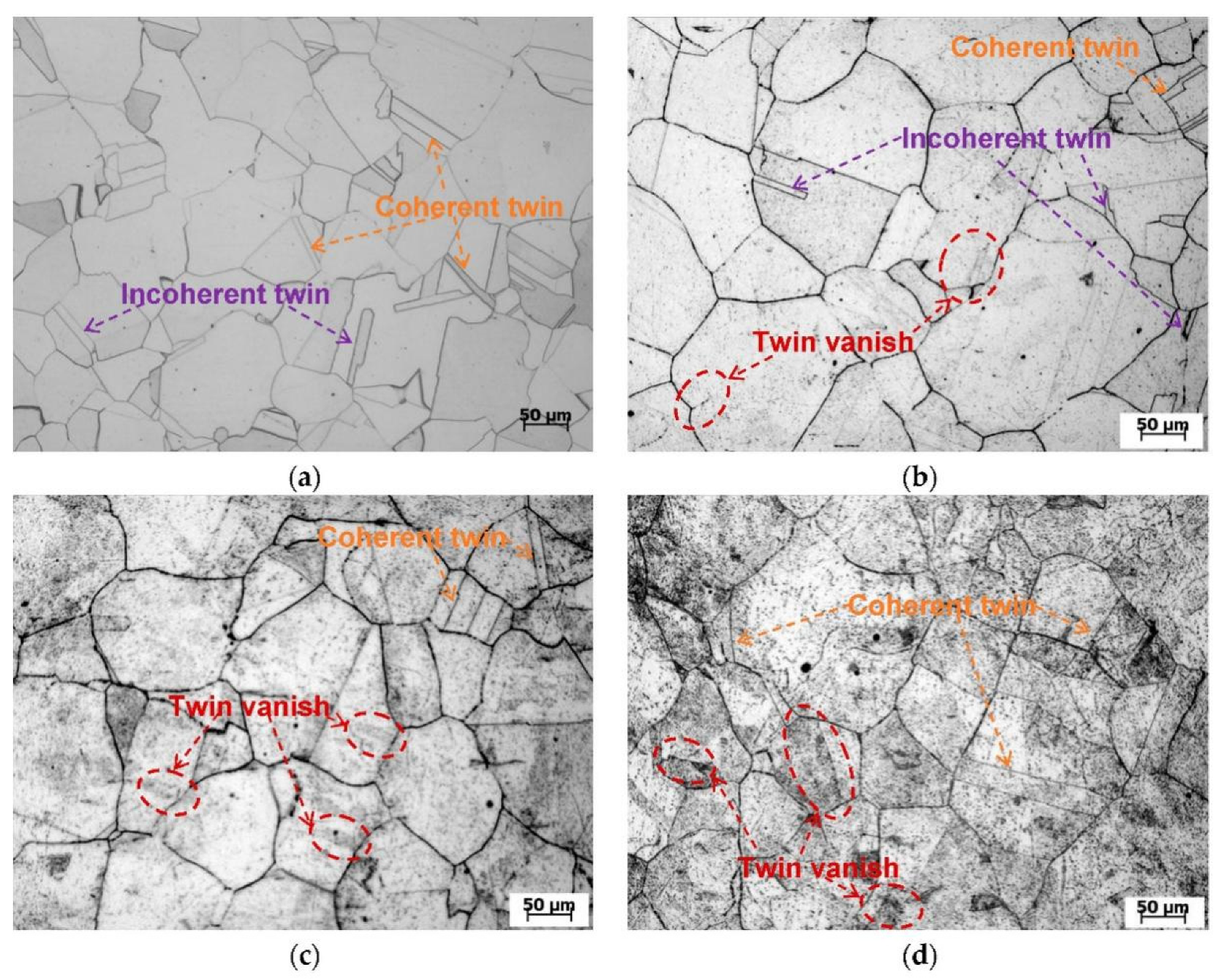
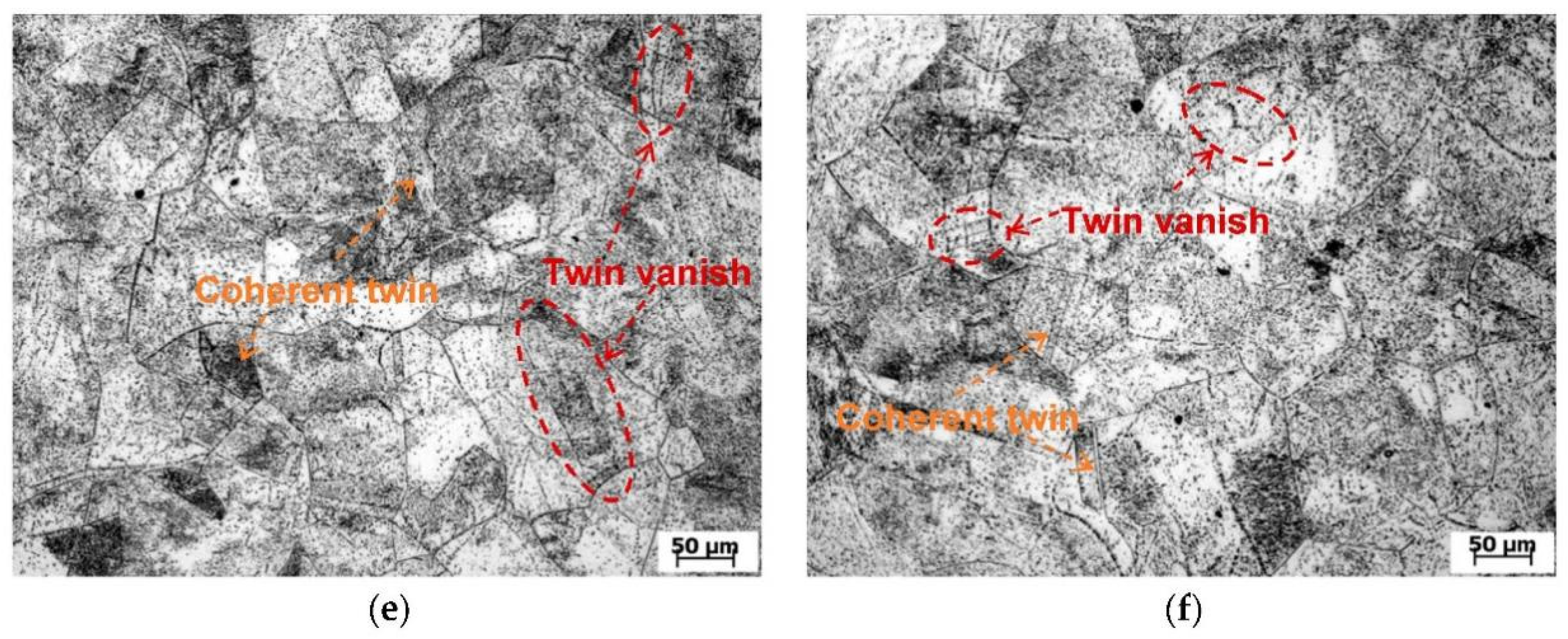
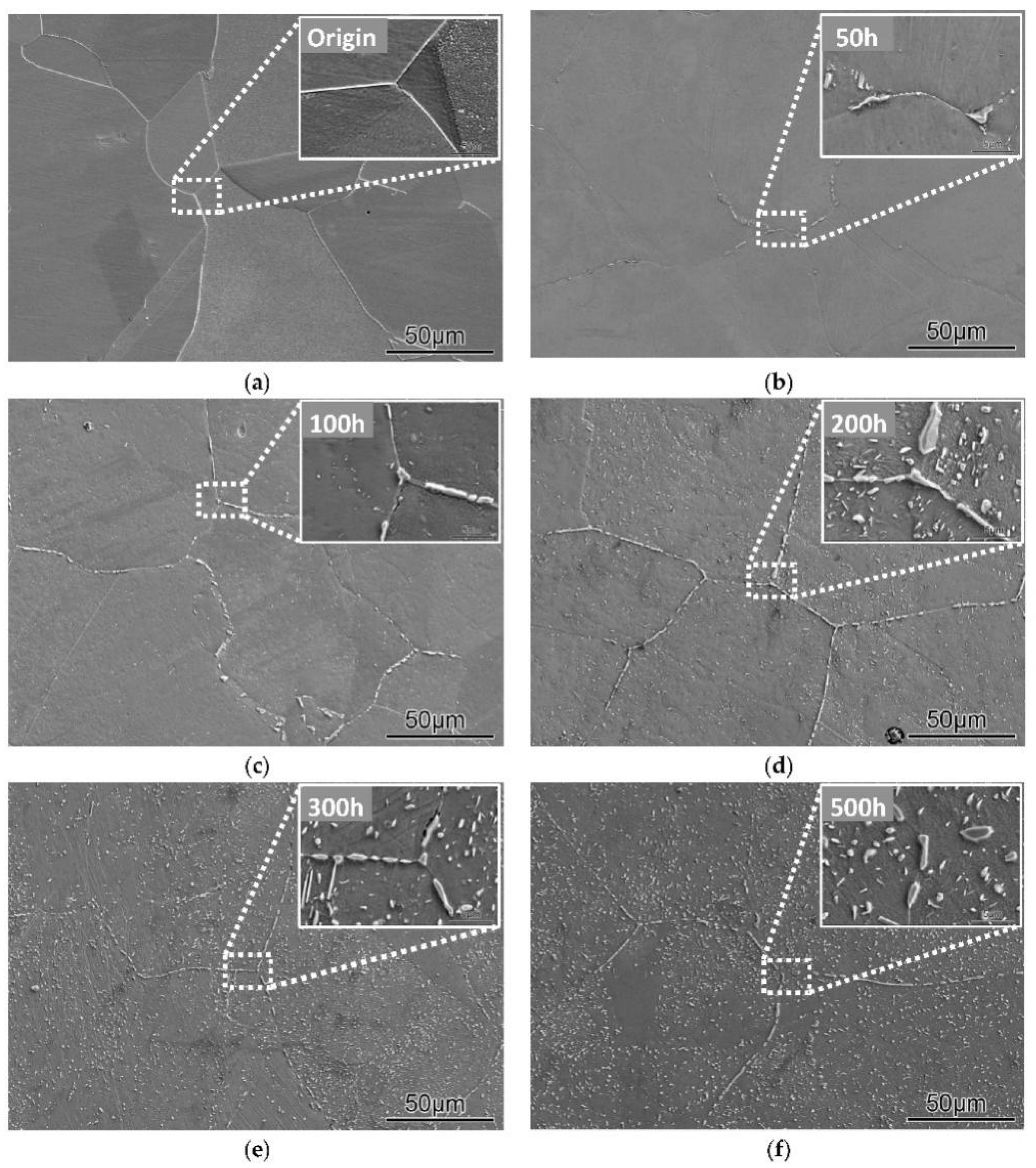
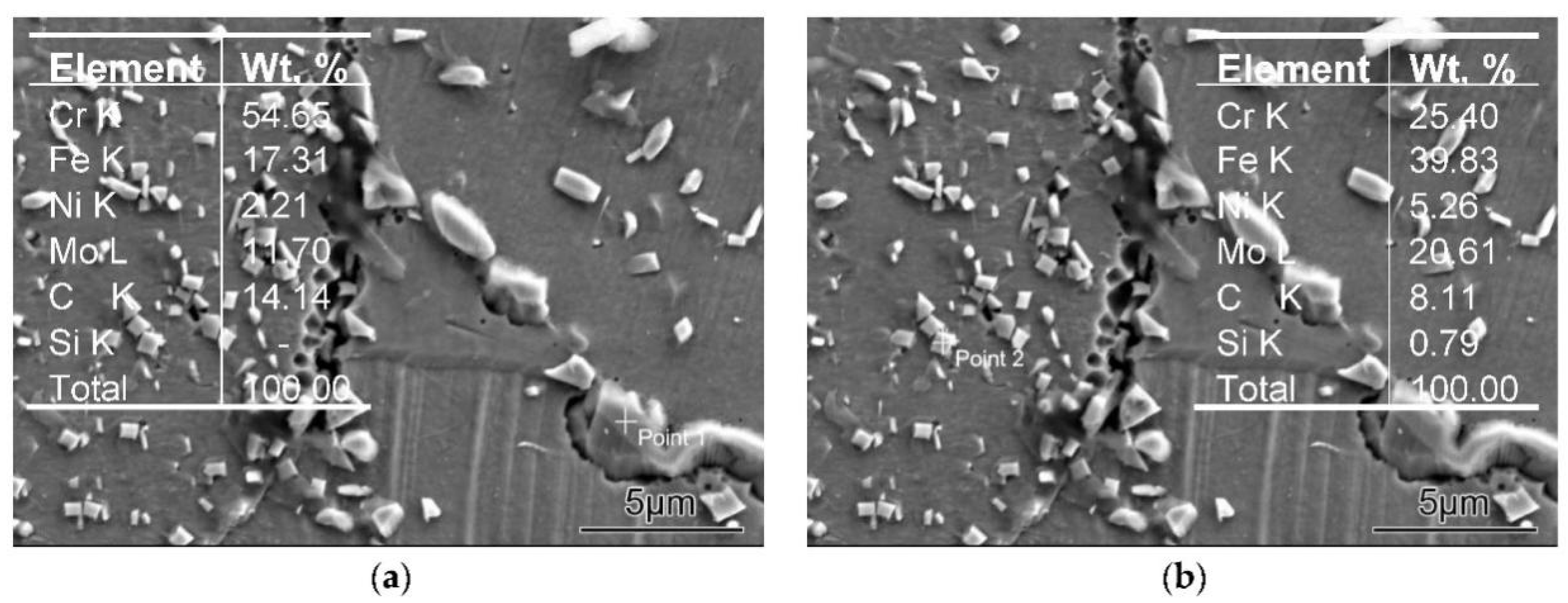
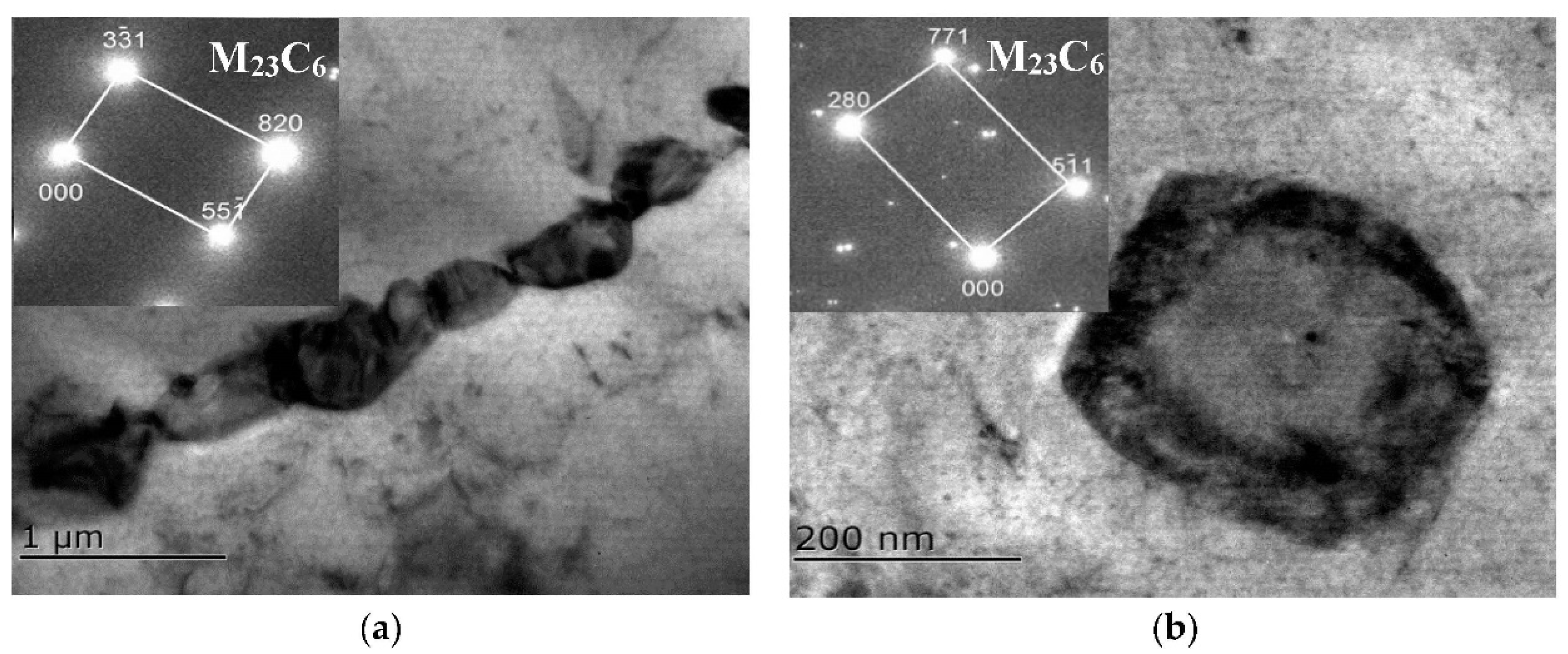


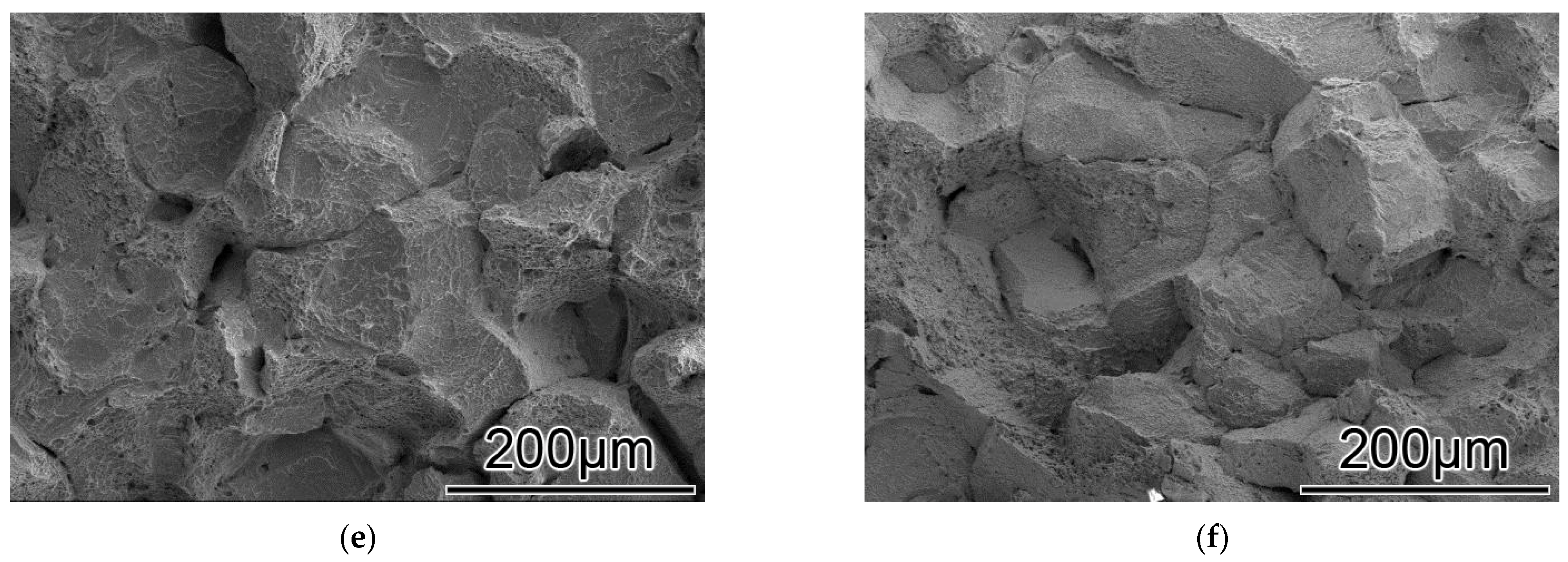
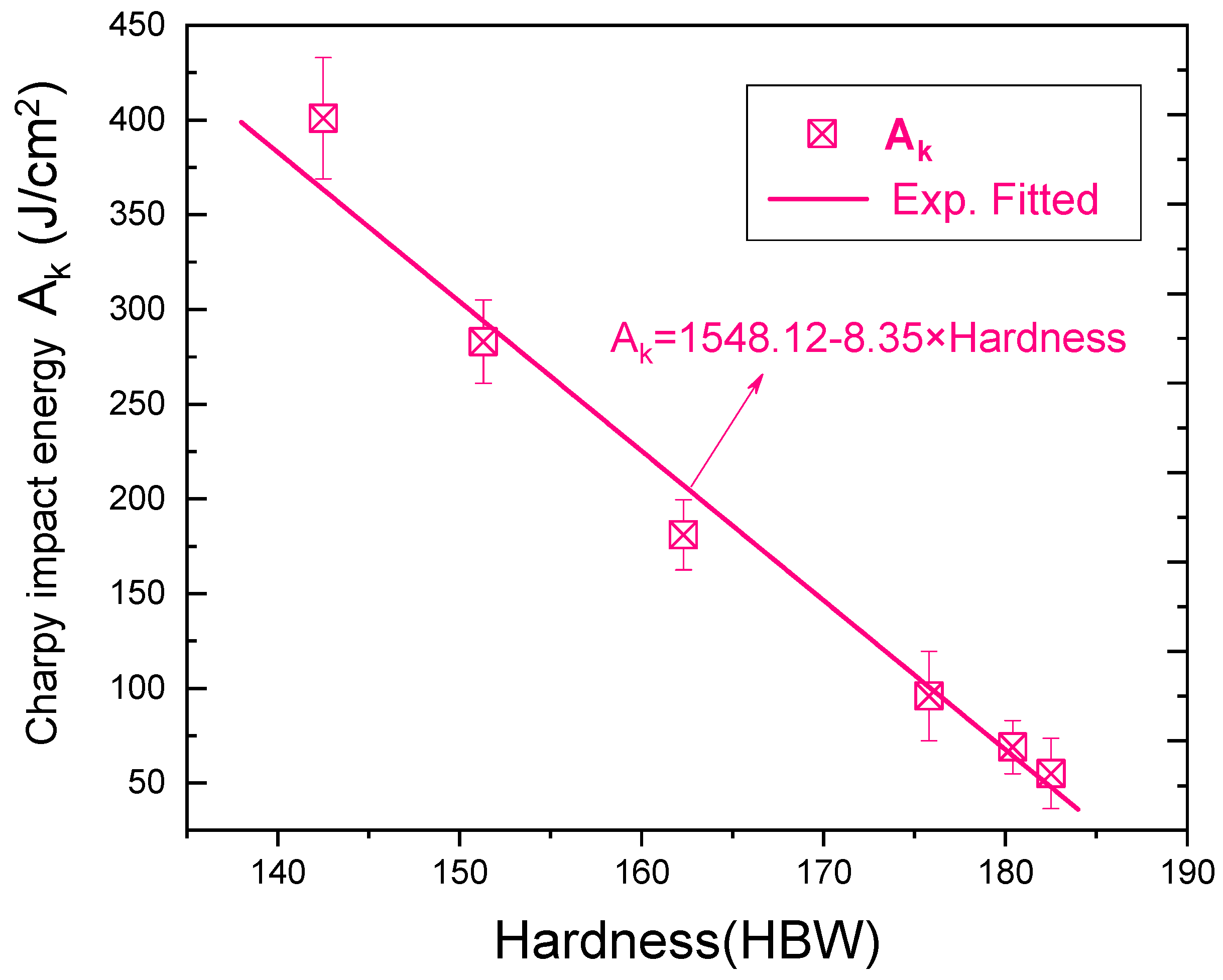
| Aging Treatment | Volume Fraction (/%) |
|---|---|
| Origin | 0 |
| 750 °C 50 h | 3.19 |
| 750 °C 100 h | 7.89 |
| 750 °C 200 h | 13.03 |
| 750 °C 300 h | 18.16 |
| 750 °C 500 h | 19.09 |
Publisher’s Note: MDPI stays neutral with regard to jurisdictional claims in published maps and institutional affiliations. |
© 2022 by the authors. Licensee MDPI, Basel, Switzerland. This article is an open access article distributed under the terms and conditions of the Creative Commons Attribution (CC BY) license (https://creativecommons.org/licenses/by/4.0/).
Share and Cite
Fang, K.; Luo, K.; Wang, L. Effect of Microstructure on Mechanical Properties of 316 LN Austenitic Stainless Steel. Coatings 2022, 12, 1461. https://doi.org/10.3390/coatings12101461
Fang K, Luo K, Wang L. Effect of Microstructure on Mechanical Properties of 316 LN Austenitic Stainless Steel. Coatings. 2022; 12(10):1461. https://doi.org/10.3390/coatings12101461
Chicago/Turabian StyleFang, Kewei, Kunjie Luo, and Li Wang. 2022. "Effect of Microstructure on Mechanical Properties of 316 LN Austenitic Stainless Steel" Coatings 12, no. 10: 1461. https://doi.org/10.3390/coatings12101461
APA StyleFang, K., Luo, K., & Wang, L. (2022). Effect of Microstructure on Mechanical Properties of 316 LN Austenitic Stainless Steel. Coatings, 12(10), 1461. https://doi.org/10.3390/coatings12101461





